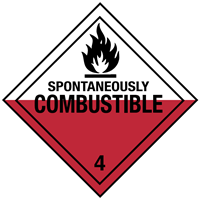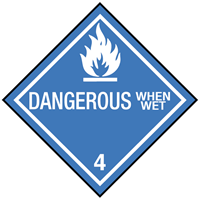
 Print
Print
Chemical Datasheet
TRIISOBUTYL ALUMINUM |


|
Chemical Identifiers
| CAS Number |
UN/NA Number |
DOT Hazard Label |
USCG CHRIS Code |
- 100-99-2

|
|
- Spontaneously Combustible
- Dangerous When Wet
|
|
| NIOSH Pocket Guide |
International Chem Safety Card |
|
none
|
none
|
NFPA 704
General Description
A colorless liquid.
Hazards
Reactivity Alerts
- Strong Reducing Agent
- Water-Reactive
- Pyrophoric
Air & Water Reactions
Pyrophoric. Reacts violently with water producing flammable gas [Rose 1961].
Fire Hazard
Special Hazards of Combustion Products: Dense smoke may cause metal-fume fever.
Behavior in Fire: Dense smoke of aluminum oxide forms. (USCG, 1999)
Health Hazard
Inhalation of smoke from fire causes metal-fume fever (flu-like symptoms). Contact with liquid can cause severe burns of eyes and skin because of spontaneous ignition. (USCG, 1999)
Reactivity Profile
TRIISOBUTYL ALUMINUM reacts violently with alcohols, phenols, amines, carbon dioxide, sulfur oxides, nitrogen oxides, halogens, and halogenated hydrocarbons, causing fire and explosion hazards [Handling Chemicals Safely 1980. p. 937].
Belongs to the Following Reactive Group(s)
- Metal Hydrides, Metal Alkyls, Metal Aryls, and Silanes
Potentially Incompatible Absorbents
No information available.
Response Recommendations
Isolation and Evacuation
Excerpt from ERG Guide 135 [Substances - Spontaneously Combustible]:
IMMEDIATE PRECAUTIONARY MEASURE: Isolate spill or leak area in all directions for at least 50 meters (150 feet) for liquids and at least 25 meters (75 feet) for solids.
SPILL: Increase the immediate precautionary measure distance, in the downwind direction, as necessary.
FIRE: If tank, rail tank car or highway tank is involved in a fire, ISOLATE for 800 meters (1/2 mile) in all directions; also, consider initial evacuation for 800 meters (1/2 mile) in all directions. (ERG, 2024)
Firefighting
Fire Extinguishing Agents Not to Be Used: Water, foam, halogenated extinguishing agents
Fire Extinguishing Agents: Inert powder (e.g., sand, limestone), dry chemical (USCG, 1999)
Non-Fire Response
Excerpt from ERG Guide 135 [Substances - Spontaneously Combustible]:
ELIMINATE all ignition sources (no smoking, flares, sparks or flames) from immediate area. Do not touch or walk through spilled material. Stop leak if you can do it without risk.
SMALL SPILL: CAUTION: For spills of Xanthates, UN3342 and for Dithionite (Hydrosulfite/Hydrosulphite), UN1384, UN1923 and UN1929, dissolve in 5 parts water and collect for proper disposal. CAUTION: UN3342 when flooded with water will continue to evolve flammable Carbon disulfide/Carbon disulphide vapors. Cover with DRY earth, DRY sand or other non-combustible material followed with plastic sheet to minimize spreading or contact with rain. Use clean, non-sparking tools to collect material and place it into loosely covered plastic containers for later disposal. Prevent entry into waterways, sewers, basements or confined areas. (ERG, 2024)
Protective Clothing
Full protective clothing, preferably of aluminized glass cloth; goggles; face shield; gloves. In case of fire, all-purpose canister or self-contained breathing apparatus. (USCG, 1999)
DuPont Tychem® Suit Fabrics
No information available.
First Aid
INHALATION: only fumes from fire need be considered; metal-fume fever lasts less than 36 hrs. and is not critical.
EYES: flush gently with copious quantities of water for 15 min. with lids open; treat burns, if fire occurred; get medical attention.
SKIN: wash with water; treat burns caused by fire; get medical attention.
INGESTION: (USCG, 1999)
Physical Properties
Flash Point: data unavailable
Lower Explosive Limit (LEL): data unavailable
Upper Explosive Limit (UEL): data unavailable
Autoignition Temperature:
Ignites spontaneously under ambient conditions
(USCG, 1999)
Melting Point:
33.8°F
(USCG, 1999)
Vapor Pressure: data unavailable
Vapor Density (Relative to Air): data unavailable
Specific Gravity:
0.788
at 68°F
(USCG, 1999)
- Less dense than water; will float
Boiling Point:
414°F
at 760 mmHg
(USCG, 1999)
Molecular Weight:
198.3
(USCG, 1999)
Water Solubility: data unavailable
Ionization Energy/Potential: data unavailable
IDLH: data unavailable
AEGLs (Acute Exposure Guideline Levels)
No AEGL information available.
ERPGs (Emergency Response Planning Guidelines)
No ERPG information available.
PACs (Protective Action Criteria)
| Chemical |
PAC-1 |
PAC-2 |
PAC-3 |
| Triisobutylaluminum (100-99-2)
|
44 mg/m3 |
290 mg/m3 |
1800 mg/m3 |
(DOE, 2024)
Regulatory Information
EPA Consolidated List of Lists
No regulatory information available.
CISA Chemical Facility Anti-Terrorism Standards (CFATS)
No regulatory information available.
OSHA Process Safety Management (PSM) Standard List
No regulatory information available.
Alternate Chemical Names
- ALUMINUM TRIISOBUTYL
- TIBA
- TIBAL
- TRIISOBUTYL ALUMINUM
- TRIISOBUTYLALUMINUM



 Print
Print

